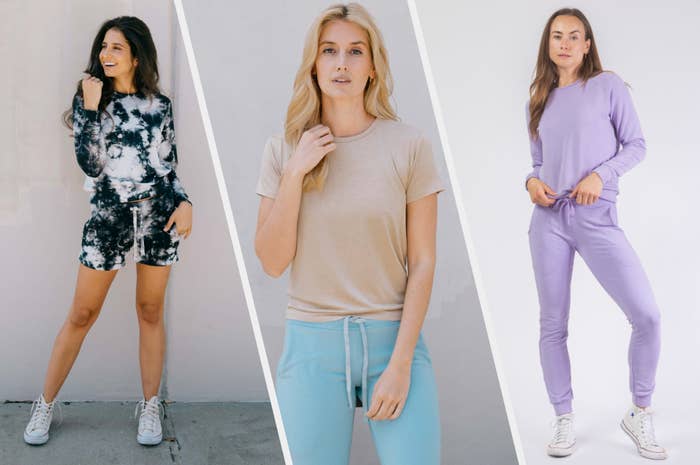The Value of Lasting Clothing: Just How It Affects the Setting and Your Wardrobe
Sustainable clothing is increasingly recognized for its vital duty in decreasing the ecological effect of the fast fashion business. By concentrating on eco-friendly materials and ethical manufacturing approaches, it addresses pressing ecological concerns. This change not only profits the planet yet also affects consumer selections, causing an extra thoughtful approach to wardrobe monitoring. Comprehending these characteristics increases essential inquiries about fashion's future and individual responsibility fit it.
The Ecological Footprint of Fast Style

Benefits of Lasting Materials
Sustainable materials use considerable advantages, particularly with environment-friendly fabric options that minimize ecological damage. These products also demonstrate toughness and durability, reducing the need for frequent replacements. Therefore, they contribute to a much more lasting fashion business and promote responsible customer behavior.
Eco-Friendly Material Selections
While the apparel industry has long been related to fast trends and ecological damage, the increase of green textile options presents a transformative possibility. Lasting materials such as natural cotton, hemp, and Tencel have gotten popularity as a result of their reduced ecological influence. These materials are often generated without unsafe chemicals and require less water, lowering their carbon footprint - Branded Clothing. Additionally, many eco-friendly materials are eco-friendly, contributing to a round economic situation by minimizing waste. Choosing lasting materials not only supports eco liable practices however likewise promotes healthier ecological communities. As customers end up being a lot more aware of their acquiring power, the demand for eco-friendly fabrics motivates brands to innovate and adopt even more sustainable manufacturing techniques, ultimately benefiting the earth and future generations
Toughness and Long Life Benefits
Several customers are significantly acknowledging the durability and durability benefits of lasting products in their garments options. Unlike conventional fabrics, sustainable materials such as organic cotton, hemp, and recycled polyester are engineered to hold up against damage, leading to garments that last much longer. This reduced regularity of replacement not just conserves consumers money with time however likewise lessens waste created by rapid style. Furthermore, sustainable clothing frequently utilizes green manufacturing techniques that boost fabric strength, adding to a decrease in the general carbon impact. By spending in long lasting garments, consumers can cultivate a much more sustainable closet while enjoying premium pieces that keep their visual and performance with time. Sturdiness and long life stand as vital advantages of choosing lasting products.
Minimizing Waste Via Sustainable Practices
Lowering waste in the style industry can be attained via innovative methods such as upcycling and repurposing products. Furthermore, taking on minimalist wardrobe strategies motivates consumers to prioritize high quality over amount, inevitably decreasing clothing intake. With each other, these methods contribute significantly to an extra sustainable clothes model.
Upcycling and Repurposing Materials
Upcycling and repurposing products have actually arised as innovative approaches in the apparel industry, changing thrown out textiles into valuable new products. This approach not just decreases waste however also encourages creativity and originality in clothing design. By taking old garments and products, designers can develop one-of-a-kind pieces that mirror personal style while lowering the demand for brand-new resources. In addition, upcycling usually requires less power and water contrasted to conventional production processes, significantly reducing the environmental impact of style. As consumers become much more familiar with sustainability, the popularity of upcycled clothing continues to rise, promoting a round economy. Ultimately, these techniques add to an extra sustainable future, where fashion focuses on ecological health over rapid manufacturing and usage.

Minimalist Wardrobe Methods
As individuals significantly look for to minimize their ecological impact, taking on minimalist closet strategies has obtained grip as a reliable technique to lasting fashion. These techniques emphasize top quality over amount, encouraging consumers to curate a smaller collection of flexible, durable garments. By focusing on timeless pieces that can be combined and matched, people can reduce the regularity of acquisitions and ultimately lower waste.Additionally, minimalism promotes conscious consumption, advising customers to assess the honest and ecological ramifications of their options. This method not just cultivates a much more lasting way of life however additionally simplifies day-to-day decision-making concerning clothes. As individuals accept minimal principles, they add to a style culture that values sustainability and accountable consumerism, eventually bring about a much more eco-conscious society.
The Duty of Honest Labor in Lasting Style
While many consumers are increasingly familiar with the ecological consequences of their clothing selections, the significance of moral labor techniques in lasting fashion can not be ignored. Moral labor includes reasonable wages, safe working conditions, and regard for workers' legal rights, forming the backbone of accountable fashion manufacturing. Brand names that prioritize honest labor not only boost neighborhoods but additionally set a criterion for responsibility in the industry.Moreover, the integration of honest methods cultivates openness, making it possible for consumers to make informed choices regarding their purchases. This practice contrasts sharply with fast fashion's unscrupulous labor designs, which typically focus on profit over people. By sustaining business committed to honest labor, customers add to a system that values human dignity together with ecological sustainability. Ethical labor is not simply an add-on; it is crucial to the more comprehensive mission of lasting fashion, making certain that the pursuit for eco-friendliness does not come at the expense of human civil liberties.
The Effect of Sustainable Clothing on Carbon Emissions
Sustainable apparel has the potential to greatly lower carbon exhausts related to the garment industry. Traditional garment production adds especially to greenhouse gas emissions, largely because of energy-intensive manufacturing processes and the use of non-renewable sources. In comparison, lasting fashion concentrates on green products, such as natural cotton or recycled fibers, which often call for much less power to produce.Moreover, lasting brand names often tend to embrace more reliable production methods, reducing waste and decreasing general discharges. By prioritizing sturdiness and timeless layout, sustainable clothes encourages consumers to buy less regularly, further lowering the carbon footprint related to overconsumption.Additionally, lots of lasting brand names are devoted to transparency in their supply chains, allowing customers to make informed choices that align with their values. Inevitably, moving towards sustainable garments can lead to a substantial reduction in carbon emissions, adding to a healthier planet and a more lasting future for the apparel industry.
Supporting Neighborhood Economic Situations With Lasting Choices
The change toward lasting garments not just addresses environmental problems but additionally substantially advantages local economies. By choosing lasting fashion, customers frequently sustain little services and local artisans, enhancing area resilience. These ventures usually operate a smaller sized scale, focusing on craftsmanship and moral practices over mass production.Investing in locally made lasting clothing promotes work development and stimulates financial growth within communities. As consumers become extra familiar with the environmental effect of their acquisitions, they significantly seek out items that reflect their values. This need encourages recommended you read neighborhood producers to adopt lasting practices, contributing to a circular economy.Moreover, supporting regional businesses reduces transportation discharges, straightening with eco-conscious customer actions. The interconnectedness of lasting garments and neighborhood economic situations highlights the essential role that individual selections play in promoting both ecological and economic health. By fostering these local connections, communities can thrive while additionally working towards a more lasting future.
Transforming Your Storage Room: Tips for a Lasting Closet
As people seek to minimize their ecological influence, transforming a storage room into a sustainable wardrobe becomes an important step. One efficient approach is to assess existing garments, maintaining just products that are worn routinely which align with sustainability goals. Focusing on quality over quantity is essential; spending in durable items from green brands can significantly decrease waste.Additionally, integrating used products can rejuvenate a wardrobe while minimizing ecological damages. Organizing clothes swaps with close friends or giving away extra things can better promote sustainability.When buying, individuals must look for materials that are natural, recycled, or biodegradable, and stay clear of rapid fashion sellers - Branded Clothing. Lastly, practicing mindful consumption by thoughtfully taking into consideration each acquisition can add to a more lasting way of living. By executing these ideas, one can create a closet that reflects individual design while supporting ecological stewardship
Regularly Asked Concerns
Exactly How Can I Recognize Lasting Garments Brands?
To identify sustainable apparel brand names, one ought to research products utilized, inspect for certifications like Fair Profession, and description check out the brand name's openness regarding their manufacturing processes, labor practices, and environmental impact, guaranteeing eco-friendly and ethical methods are focused on.
What Are the Costs Related To Lasting Style?
The expenses connected with lasting fashion can vary considerably. Greater manufacturing expenses, ethical sourcing, and environmentally friendly materials typically bring about enhanced retail rates, which might deter some customers while interesting ecologically mindful customers.
Can Lasting Apparel Be Fashionable and elegant?
Sustainable clothes can without a doubt be trendy and trendy. Developers significantly prioritize ingenious materials and ethical manufacturing methods, proving that fashion and sustainability can exist together. Consumers currently have varied choices that blend aesthetics with environmental awareness.
Exactly How Does Laundering Clothes Affect Their Sustainability?
Washing garments substantially influences sustainability by consuming water and power, contributing to pollution, and triggering microplastic launch. Frequent cleaning can deteriorate fabrics, reducing their life-span and increasing the demand for substitutes, ultimately aggravating ecological issues.
What Is the Life-span of Sustainable Clothes Compared to Rapid Fashion?
The life expectancy of sustainable clothes normally exceeds that of fast style products, frequently long lasting a number of years due to high quality products and craftsmanship. On the other hand, fast fashion garments might weaken promptly, requiring more regular replacements. Lasting apparel is progressively acknowledged for its vital function in reducing the environmental effect of the rapid here fashion sector. While lots of consumers are progressively conscious of the ecological repercussions of their clothing choices, the relevance of ethical labor methods in sustainable style can not be ignored. Branded Clothing. Sustainable clothing has the potential to considerably lower carbon exhausts connected with the style industry. In contrast, lasting style focuses on green materials, such as natural cotton or recycled fibers, which frequently need less energy to produce.Moreover, lasting brand names often tend to embrace extra effective production practices, minimizing waste and lowering general discharges. By prioritizing resilience and timeless style, lasting clothes urges consumers to get much less often, further minimizing the carbon impact associated with overconsumption.Additionally, lots of lasting brand names are dedicated to transparency in their supply chains, making it possible for customers to make informed selections that straighten with their worths